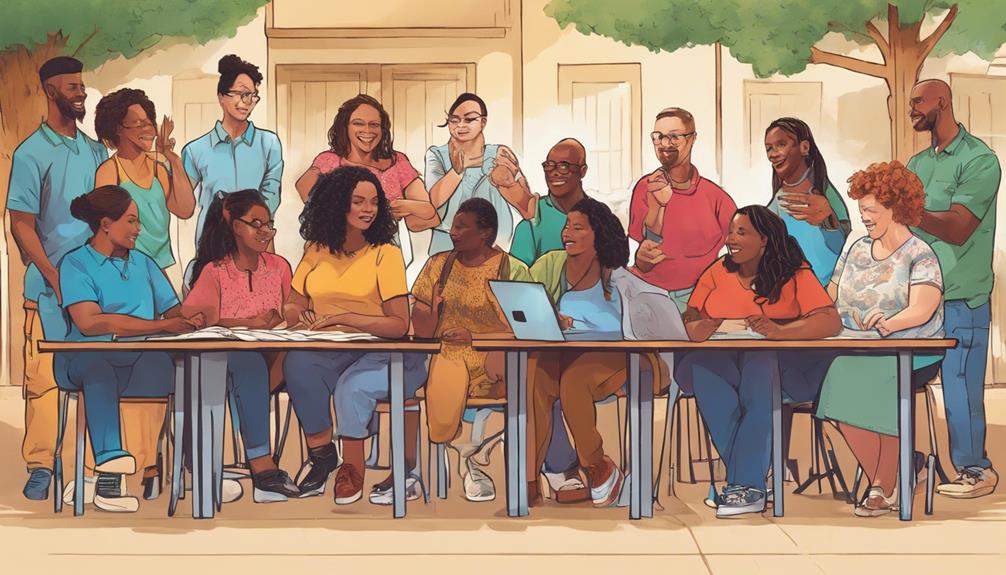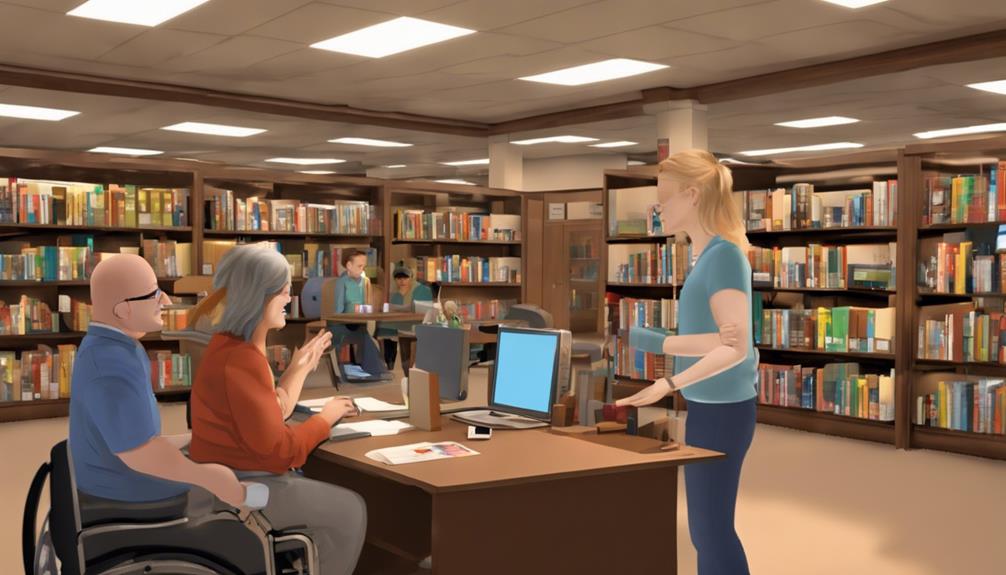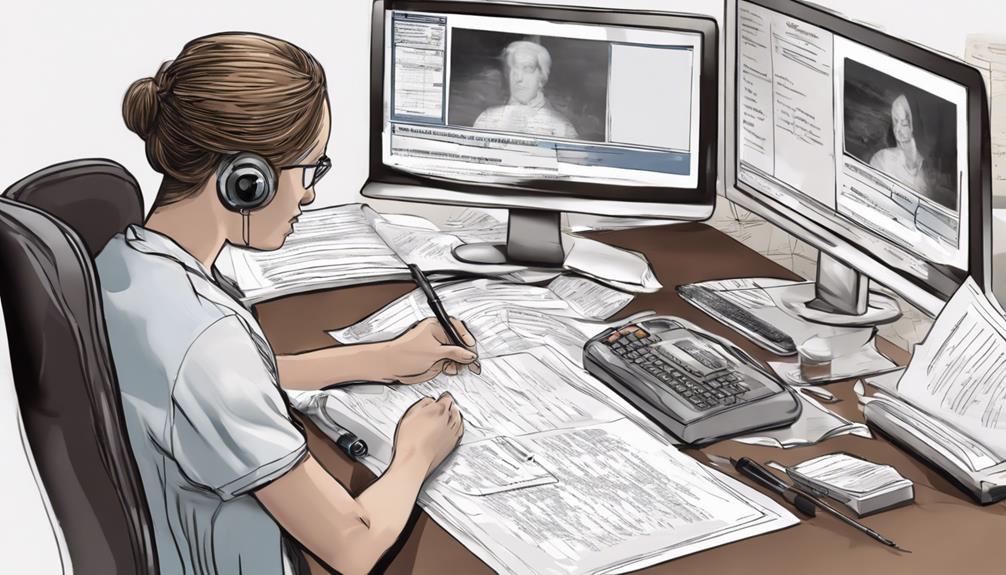Upon first discovering the narrative of Sarah, a Deaf college student making her way through the intricacies of higher education, it illuminated the distinct hurdles and victories experienced by the Deaf community in America.
Understanding the intricacies of Deaf culture is not just about learning a new language; it's about immersing oneself in a vibrant world filled with rich traditions and perspectives waiting to be discovered.
Exploring the foundations of American Deaf culture can provide valuable insights into a community often misunderstood, paving the way for deeper connections and mutual understanding.
Key Takeaways
- ASL is a distinct language with regional variations and cultural influences.
- Deaf identity fosters community, pride, and empowerment through shared experiences.
- Cultural traditions like storytelling and celebrations enhance Deaf heritage.
- Advocacy efforts promote Deaf rights, awareness, and equal access to information.
History of American Sign Language
The origins of American Sign Language (ASL) can be traced back to the early 19th century when it first emerged at the American School for the Deaf in Hartford, Connecticut. Developed by Deaf individuals, ASL is a unique visual-gestural language, not simply a translation of English. It has its own grammar and syntax, allowing for complex communication without the need for spoken words.
Just like spoken languages, ASL exhibits regional variations and dialects, influenced by the diverse Deaf communities across America. The evolution of ASL has been profoundly shaped by Deaf culture, incorporating cultural norms, expressions, and storytelling techniques that are integral to the Deaf community's identity and unity.
Linguists recognize ASL as a legitimate language, distinct from English, underscoring its importance in fostering communication and connection within the Deaf community. The rich history of ASL continues to inspire innovation and appreciation for the visual language that plays a vital role in Deaf culture.
Importance of Deaf Identity
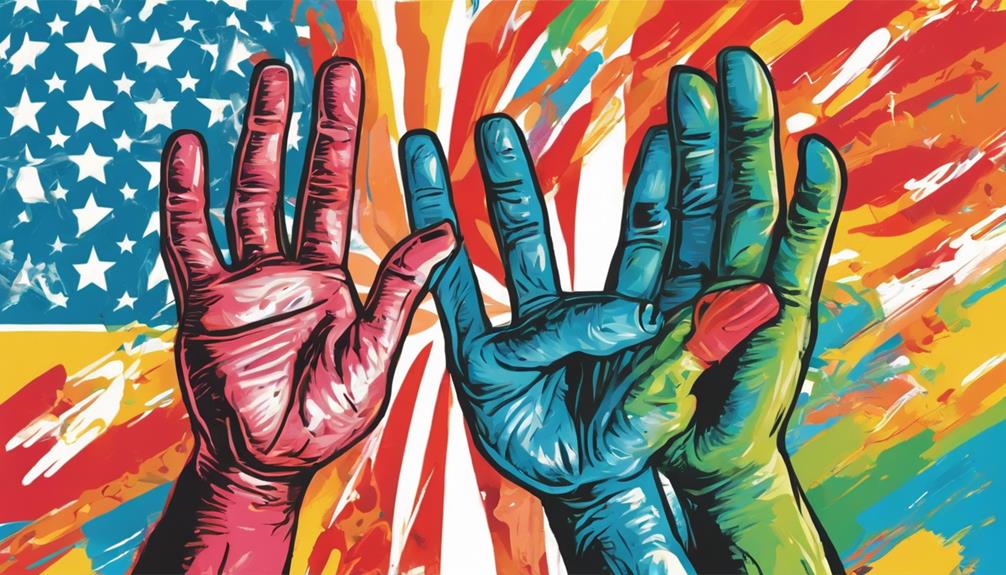
Rooted in a vibrant cultural heritage that celebrates visual communication and community connections, Deaf identity holds profound significance in shaping the experiences and perspectives of individuals within the Deaf community. Deaf identity goes beyond just the inability to hear; it encompasses a rich tapestry of shared experiences, traditions, and values that unite Deaf individuals. Central to Deaf identity is the use of American Sign Language (ASL), which serves not only as a mode of communication but also as a vital medium for cultural expression and connection.
Within the Deaf community, embracing one's Deaf identity fosters a sense of belonging, pride, and empowerment. It provides a framework through which Deaf individuals navigate the world, advocate for their rights, and promote inclusivity. By recognizing and honoring Deaf identity, individuals within the Deaf community find strength in their shared experiences and traditions, forging a collective identity that celebrates diversity and resilience. Embracing Deaf identity isn't just a personal choice but a vital aspect of maintaining the vibrant tapestry of the Deaf community.
Cultural Traditions and Celebrations
Embracing Deaf identity opens the door to a world rich in cultural traditions and vibrant celebrations that shape the tapestry of the Deaf community. Deaf cultural traditions are deeply rooted in visual storytelling, with American Sign Language (ASL) poetry and folklore playing significant roles. These forms of expression not only preserve the history and values of the Deaf community but also serve as a means of passing down stories from generation to generation.
When it comes to celebrations, the Deaf community comes together to honor their heritage through events like Deaf History Month and Deaf Awareness Week. These occasions provide opportunities for education, reflection, and unity among Deaf individuals and their allies. Additionally, cultural celebrations often feature traditional Deaf games such as 'Deaf Bingo' and 'Deaf Pictionary,' fostering a sense of camaraderie and joy within the community.
Art is another cornerstone of Deaf culture, with a particular emphasis on visual arts like De'VIA and ASL storytelling performances. These artistic expressions not only showcase creativity but also serve as powerful tools for communication and cultural preservation. Unique customs like the 'Deaf President Now' movement and Deaf pride marches further highlight the strength and resilience of the Deaf community in celebrating their identity and advocating for their rights.
Understanding Deaf Communication

When it comes to understanding Deaf communication, grasping the basics of Sign Language and visual cues is fundamental.
Visual communication cues, such as facial expressions and body language, are essential components in conveying emotions and information effectively within Deaf culture.
Utilizing these communication methods alongside assistive devices and interpreters helps bridge the gap between Deaf and hearing individuals for seamless interactions.
Sign Language Basics
Exploring the fundamentals of American Sign Language (ASL) provides a crucial gateway to understanding the intricate world of Deaf communication. ASL, a visual-gestural language used within Deaf Culture, has its own grammar, syntax, and structure, distinct from English.
Handshapes, facial expressions, and body movements are key components of ASL, conveying meaning and emotions effectively. It's essential to note that ASL varies by region, with different dialects similar to spoken languages.
Learning ASL not only enhances communication but also serves as a bridge between Deaf and hearing individuals. Embracing ASL opens up a world of expression and connection, enriching interactions and fostering a deeper understanding of the vibrant Deaf Culture.
Visual Communication Cues
Visual communication cues play a vital role in Deaf culture, utilizing facial expressions, body language, and eye contact to convey nuanced meanings and emotions effectively. Deaf individuals rely on these cues, along with American Sign Language (ASL), to express thoughts and emotions. Hand gestures and facial expressions enhance communication, allowing for the conveyance of subtle nuances.
These cues are integral tools in daily interactions, emphasizing the significance of non-verbal expressions in Deaf culture. Understanding visual communication cues is essential for effective communication with Deaf individuals, facilitating better connections and mutual understanding. By being attuned to these visual cues, one can engage more meaningfully with the Deaf community, fostering inclusivity and enhancing communication experiences.
Sign Language Variations and Dialects
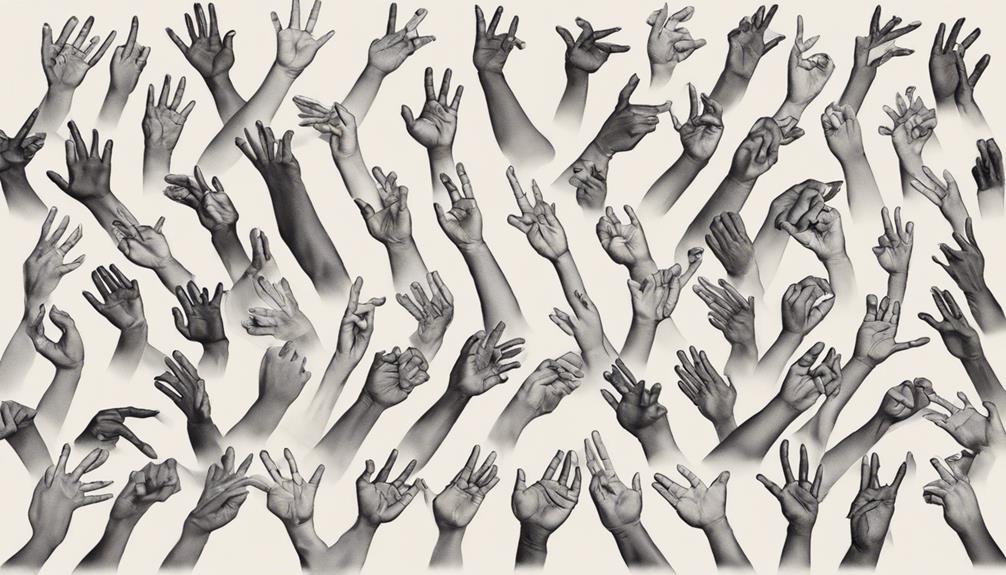
Within the rich tapestry of American Sign Language (ASL) lies a fascinating array of regional variations and dialects that reflect the diverse cultural landscape of the Deaf community. ASL dialects showcase the linguistic richness of sign language and the unique identity of Deaf individuals.
Here are three key points to help you delve deeper into the world of ASL variations:
- Differences in Handshapes: ASL signs can vary in handshapes across different regions, influencing the meaning and expression of signs.
- Varied Movement Patterns: The movement components of signs in ASL can differ regionally, adding layers of nuance and cultural significance to communication.
- Facial Expressions and Gestures: Facial expressions play a crucial role in ASL dialects, conveying emotions and nuances that enhance the overall message being signed.
Understanding these variations is essential for effective communication and cultural exchange within the Deaf community, highlighting the importance of embracing the diversity present in ASL dialects.
Role of Deaf Schools and Communities
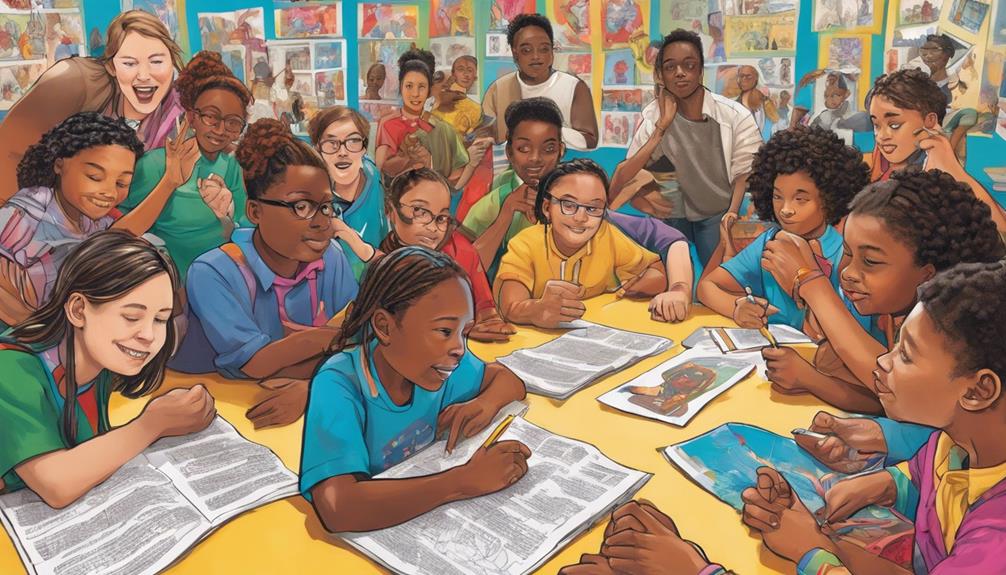
Deaf schools serve as crucial hubs for Deaf students, fostering linguistic and cultural growth through the use of American Sign Language. These institutions provide a supportive environment where individuals can connect with peers who share similar experiences and identity.
Additionally, Deaf communities outside of school settings offer further support, camaraderie, and opportunities for involvement in cultural events and advocacy efforts.
Deaf School Importance
Indispensable to the development and preservation of American Deaf culture, schools catering to the Deaf community play a vital role in nurturing identity and fostering a sense of belonging among Deaf students. Deaf schools serve as more than just educational institutions; they're pillars of the Deaf community, offering a supportive environment where students can thrive. Here are three key aspects highlighting the importance of Deaf schools:
- Promoting Deaf pride: Deaf schools instill a sense of pride in Deaf identity, encouraging students to embrace who they are.
- Fostering community involvement: These schools actively engage students in the Deaf community, promoting a sense of belonging and connection.
- Enhancing cultural awareness: Deaf schools emphasize the importance of cultural awareness, creating an environment where Deaf culture is celebrated and preserved.
Community Support Networks
Moving from the foundational support provided by Deaf schools, the collaborative network between these educational institutions and Deaf communities forms a robust system of support and empowerment for individuals within the Deaf culture. Deaf schools serve as cultural hubs, nurturing pride and identity through the use of American Sign Language (ASL) and promoting linguistic and cultural development. On the other hand, Deaf communities offer social support, language access, and a sense of belonging, allowing Deaf individuals to connect, share experiences, and celebrate their unique heritage. Together, Deaf schools and communities create a vibrant ecosystem that fosters a strong cultural identity, empowers Deaf leaders, and advocates for the needs of the Deaf community.
| Deaf Schools | Deaf Communities |
|---|---|
| Cultural identity | Social support |
| ASL communication | Language access |
| Heritage celebration | Belonging |
| Empowerment | Community connection |
Cultural Events Involvement
Playing a pivotal role in fostering cultural identity and pride, both Deaf schools and communities actively engage in organizing and participating in a variety of cultural events. Deaf schools contribute significantly to the vibrant cultural scene by hosting events that celebrate Deaf culture and heritage. These events serve as platforms for showcasing talents, sharing stories, and educating others about the richness of Deaf identity. Involvement in cultural events at Deaf schools not only fosters a sense of community and belonging but also enhances students' language skills and cultural knowledge. Through these activities, students develop a deeper appreciation for their heritage and form strong connections with the larger Deaf community.
- Deaf schools host cultural celebrations like Deaf Awareness Week.
- Cultural events at Deaf schools promote social interaction and immersion.
- Participation enhances language skills and well-being.
Art and Media Representation
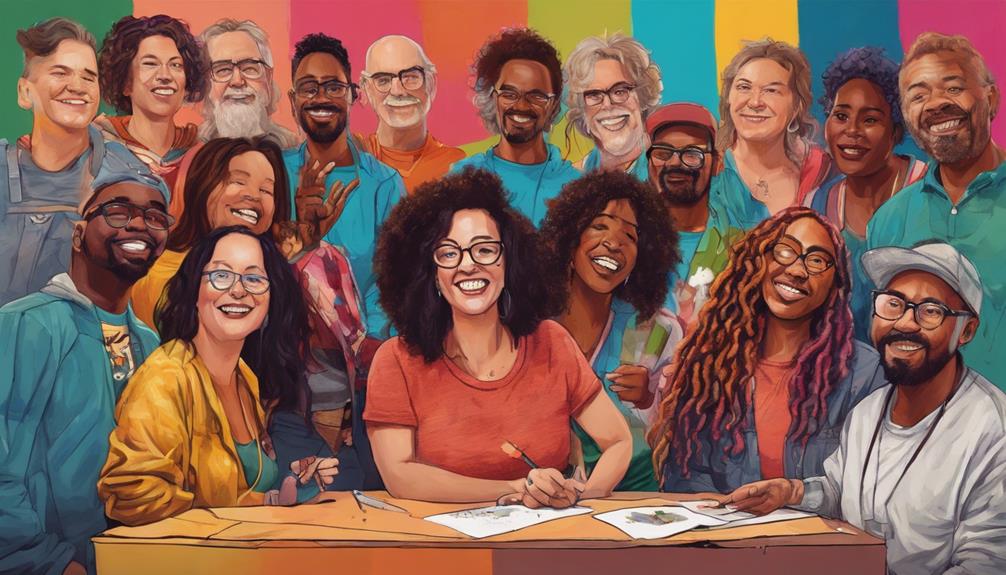
Art and media representations within American Deaf culture serve as vital conduits for preserving and sharing the rich cultural heritage of the Deaf community. Deaf literature, with its unique storytelling and linguistic features, serves as a powerful tool for cultural preservation and representation. It allows Deaf individuals to express their experiences, perspectives, and cultural identity through written works.
Similarly, Deaf art plays a crucial role in enhancing understanding of Deaf people's lives and histories. Through various art forms such as visual arts, performance arts, and film, Deaf artists contribute significantly to the historical narrative and storytelling traditions of Deaf culture.
Deaf literature and art promote inclusivity and awareness of the unique cultural nuances and richness of the Deaf community. They've also facilitated broader recognition and appreciation of Deaf cultural heritage, breaking barriers and fostering a deeper understanding of Deaf culture among both Deaf and hearing audiences. The evolution and accessibility of Deaf literature and art have further propelled the representation of Deaf culture in mainstream media, enriching the cultural landscape with diverse narratives and perspectives.
Deaf Activism and Advocacy
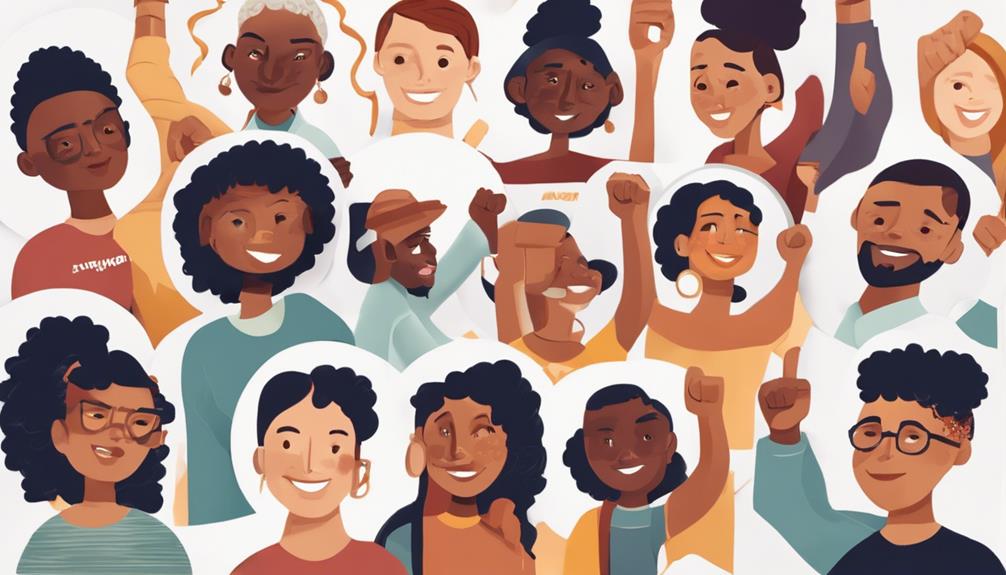
In the realm of Deaf activism and advocacy, a resolute commitment to promoting the rights, resources, and cultural acceptance of the Deaf community underpins our unwavering efforts. Deaf activism focuses on challenging societal norms, combating discrimination, and fostering Deaf cultural pride. Advocacy efforts aim to enhance education, employment, and healthcare opportunities for Deaf individuals.
Here are three key aspects that drive our Deaf activism and advocacy initiatives:
- Promoting Deaf Rights: Activists strive to ensure that Deaf individuals have equal access to opportunities and aren't discriminated against based on their hearing status.
- Raising Awareness: Advocates work tirelessly to educate the public about Deaf culture, needs, and challenges faced by the Deaf community.
- Empowering the Deaf Community: Through various platforms like social media, protests, and legal avenues, we empower Deaf individuals to advocate for themselves and create positive change in society.
Technology and Accessibility

Technology has significantly advanced accessibility for Deaf individuals, with tools like sign language interpreters, video relay services, and closed captioning options playing vital roles. These innovations have revolutionized communication and media consumption, providing efficient ways for Deaf individuals to connect and enjoy content.
Cochlear implants and hearing aids have also contributed to enhancing the lives of some Deaf individuals in specific situations.
Sign Language Interpreters
Sign language interpreters play a vital role in bridging communication gaps between Deaf individuals and hearing individuals. They utilize technology advancements to enhance accessibility through services like video relay and remote interpreting. These interpreters undergo specialized training to ensure accurate and culturally sensitive interpretation in various settings, including legal, medical, educational, and social contexts for Deaf individuals.
- Specialized training ensures accurate interpretation
- Facilitate communication in legal, medical, educational, and social contexts
- Growing demand highlights the importance of sign language interpreters
Video Relay Services
Utilizing cutting-edge technology, Video Relay Services (VRS) revolutionize communication accessibility for Deaf individuals by facilitating real-time interactions through sign language interpreters. VRS enables Deaf individuals to engage in seamless communication with hearing individuals, breaking down barriers and fostering inclusivity. This innovative technology offers 24/7 availability, empowering Deaf individuals to make phone calls independently and efficiently. Whether in the workplace, educational settings, or daily interactions, VRS plays a crucial role in enhancing accessibility and ensuring equal opportunities. The real-time video connections provided by VRS not only bridge the communication gap between Deaf and hearing individuals but also significantly improve the quality of life for Deaf individuals by granting them greater independence and freedom in their interactions.
| Key Benefits of Video Relay Services | ||
|---|---|---|
| Enhances accessibility | Enables independence | Fosters inclusivity |
| Provides real-time communication | Improves quality of life |
Closed Captioning Options
With the advancements in communication accessibility for Deaf individuals through Video Relay Services, exploring the various closed captioning options becomes essential in enhancing inclusivity and ensuring equal access to information and media content.
- Real-time captioning: Utilized for live events, offering immediate text display of spoken words.
- Offline captioning: Pre-recorded content is captioned beforehand, ensuring accuracy and quality.
- Open captions: Embedded in the video, these captions are always visible and can't be turned off.
Understanding these closed captioning options is crucial in upholding accessibility standards set forth by the Americans with Disabilities Act (ADA) and promoting inclusivity within the Deaf culture. Captions play a vital role in providing equal access to information and media content for individuals who are Deaf or hard of hearing.
Moving Forward in Deaf Culture
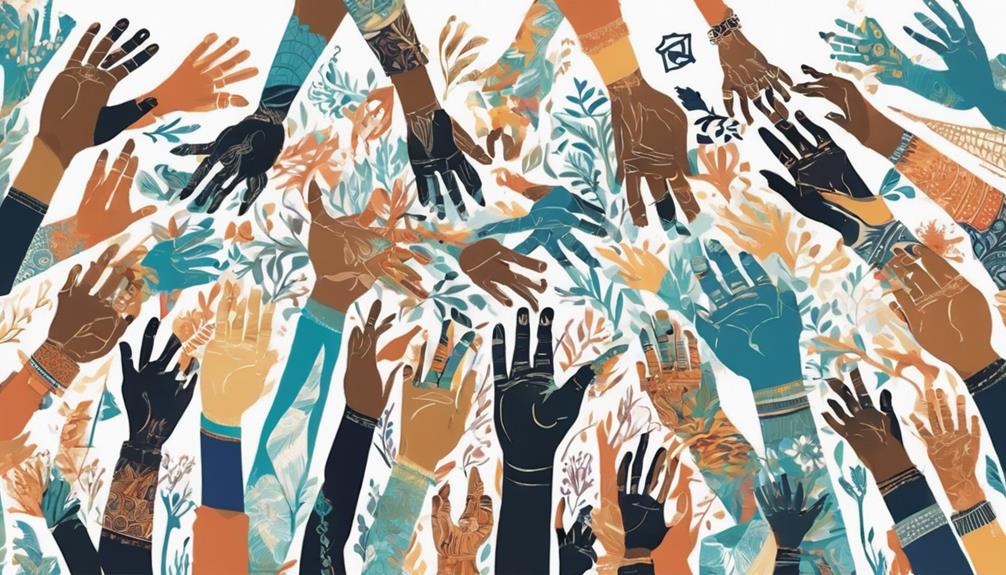
Navigating the intricacies of Deaf culture requires a deep understanding of the stages of cultural awareness and a commitment to personal growth within the Deaf community. Developing self-awareness and integrating into the Deaf community are vital steps in advancing within Deaf culture. Embracing one's cultural identity and fostering acceptance are pivotal for progress. American Sign Language (ASL) serves as a fundamental tool for communication and fostering inclusivity within the Deaf community. Furthermore, exploring Deaf literature, art, and their contributions can greatly enrich one's comprehension and admiration of Deaf culture progression.
| Key Aspects of Moving Forward in Deaf Culture | |
|---|---|
| Understanding cultural awareness stages | Developing self-awareness |
| Settling into the Deaf community | Embracing cultural identity |
| Utilizing American Sign Language (ASL) | Exploring Deaf literature & art |
Frequently Asked Questions
What Is the Purpose of the Book Deaf Culture?
The purpose of exploring Deaf culture is to understand the unique perspectives, norms, and experiences of Deaf individuals. By delving into Deaf culture, we gain insights into their rich history, language, and community.
This knowledge helps us appreciate the diversity and vibrancy of the Deaf community, fostering inclusivity and breaking down barriers. Understanding Deaf culture allows for more effective communication, respect, and support for Deaf individuals in various aspects of life.
What Are 3 Aspects of Deaf Culture?
Three aspects of Deaf culture include:
- Celebrating American Sign Language as a vital form of communication and identity.
- Emphasizing visual communication, storytelling, and visual arts.
- Valuing community gatherings to nurture a sense of belonging.
These elements showcase the rich tapestry of Deaf culture, highlighting the importance of language, visual expression, and community connections in fostering pride, identity, and advocacy within the Deaf community.
Conclusion
In conclusion, exploring the vibrant tapestry of American Deaf culture reveals a rich history, diverse traditions, and impactful advocacy efforts. Embracing the essence of Deaf identity, celebrating cultural milestones, and championing accessibility through technology are vital components of advancing Deaf culture.
By fostering a deeper understanding of Deaf communication, sign language variations, and artistic representations, we can collectively contribute to the flourishing future of Deaf culture. Let's continue to amplify awareness, appreciation, and advocacy for American Deaf culture.

